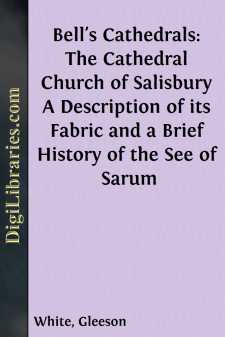Categories
- Antiques & Collectibles 13
- Architecture 36
- Art 48
- Bibles 22
- Biography & Autobiography 813
- Body, Mind & Spirit 142
- Business & Economics 28
- Children's Books 15
- Children's Fiction 12
- Computers 4
- Cooking 94
- Crafts & Hobbies 4
- Drama 346
- Education 46
- Family & Relationships 57
- Fiction 11828
- Games 19
- Gardening 17
- Health & Fitness 34
- History 1377
- House & Home 1
- Humor 147
- Juvenile Fiction 1873
- Juvenile Nonfiction 202
- Language Arts & Disciplines 88
- Law 16
- Literary Collections 686
- Literary Criticism 179
- Mathematics 13
- Medical 41
- Music 40
- Nature 179
- Non-Classifiable 1768
- Performing Arts 7
- Periodicals 1453
- Philosophy 64
- Photography 2
- Poetry 896
- Political Science 203
- Psychology 42
- Reference 154
- Religion 513
- Science 126
- Self-Help 84
- Social Science 81
- Sports & Recreation 34
- Study Aids 3
- Technology & Engineering 59
- Transportation 23
- Travel 463
- True Crime 29
Bell's Cathedrals: The Cathedral Church of Salisbury A Description of its Fabric and a Brief History of the See of Sarum
by: Gleeson White
Categories:
Description:
Excerpt
here is probably no cathedral church in Europe, certainly no other English one, that has such a clear record of its history as Salisbury. Whereas in almost every other instance we have only vague legendary accounts of the original foundation of the building, in this case there is a trustworthy chronicle of its first inception and each successive stage of its progress extant.
Owing to reasons noted in another chapter, the former cathedral at Old Sarum was condemned to be abandoned, and a new site chosen for its successor; Bishop Richard Poore, through whose efforts the change of locality was effected, is said to have hesitated long before he could find one suitable. Wilton, then a place of some importance, attracted him first. There is a more or less accurate MS. extant which professes to give an account of his tentative attempts to induce the Abbess of Wilton to permit him to build his church in a meadow of her domain. An old sewing-woman (quaedam vetula filatrix) is said to have attributed his frequent visits to quite another motive; she inferred that the Bishop had a papal dispensation to marry, and was a suitor for the hand of the Abbess. The negotiations failed: "Hath not the Bishop land of his own that he must needs spoil the Abbess? Verily he hath many more sites on which he may build his church than this at Wilton," was the reply of the Abbess to his demand. During his period of indecision the Virgin appeared to him in a vision, and commanded him to build his new church in a place called Myr-field, or, as some accounts have it, Maer-field. He searched vainly for a piece of ground by that name, that he might obey the supernatural edict, until by chance he overheard a labourer (or a soldier, the legends vary,) talking of the Maer-field, and then having, as he thought, identified the place, which appears to have been within his own demesne, he commenced to plan the present building. Another tradition ignores the dream, and says the site of the cathedral was determined by an arrow shot from the ramparts of Old Sarum.
Misled by the similarity of sound, the name Maer-field has been, naturally enough, interpreted to mean Mary-field. The apparently obvious form "Miry-field,"—as, according to Leland, it appears on an old inscription,—in spite of the marshy nature of the site, is probably a mere coincidence. Nor is Thomas Fuller's "Merry-field, for the pleasant situation thereof," better worth attention. The generally accepted theory at present is that maer, the Anglo-Saxon word for a boundary, supplies the clue. A hamlet, Marton, near Bedwin, another of the same name now corrupted to Martin, near Damerham, might each be truly described as boundary-towns. In Wiltshire to-day 'mere-stone' is the local idiom for a boundary-stone. Mere is alike the name of a hundred and of a parish in Wilts, both near its borders. The site of the present cathedral is at the junction of three ancient hundreds—Underditch, Alderbury, and Cawdon—the south-east wall of the close being the boundary line which divides the cathedral precincts from Cawdon.
Not only from the fact that the site was given by the bishop may we infer that the Poores were a wealthy family; but his brother Herbert, who was his immediate predecessor in the see, is described in the Osmund Register, as dives et assiduus (rich and painstaking), and Richard Poore before his enthronement was a benefactor to the monastery of Tarrant, in Dorsetshire, his native village....



